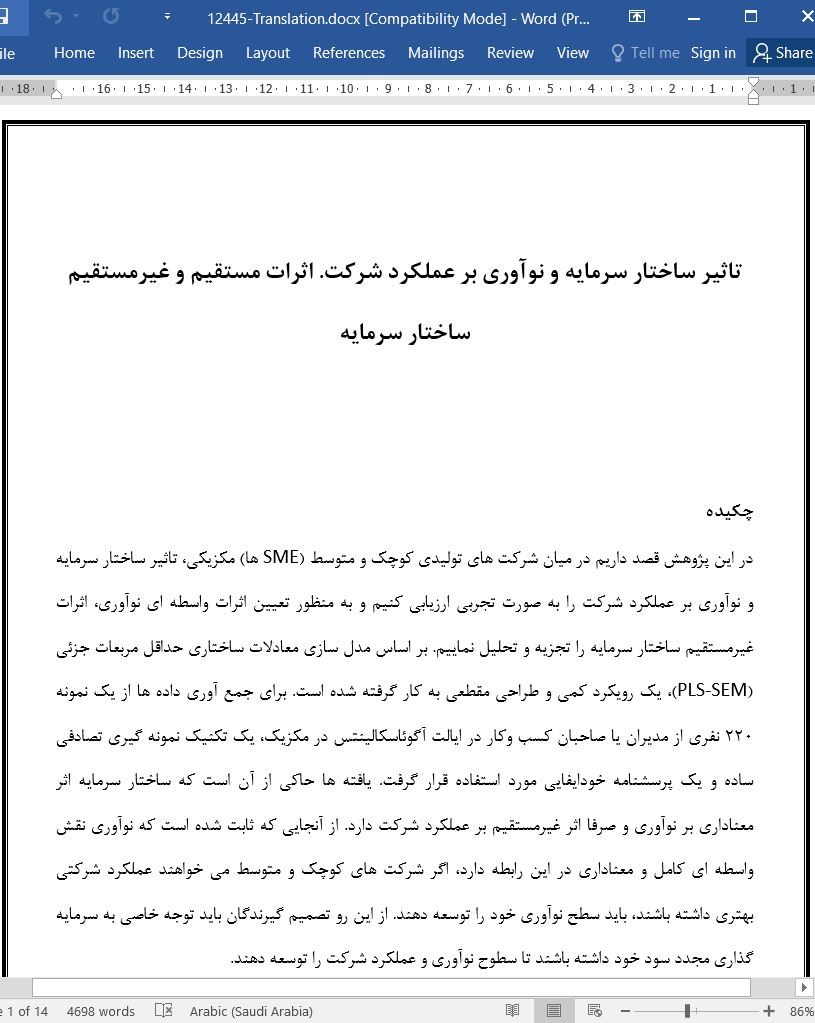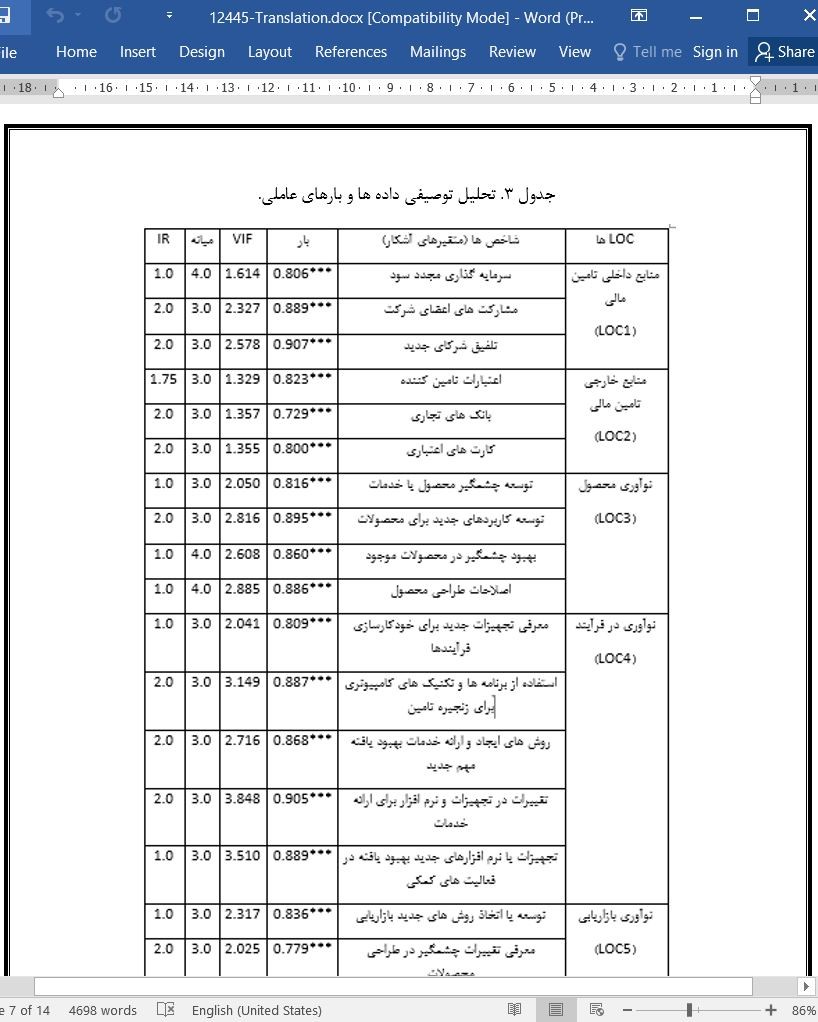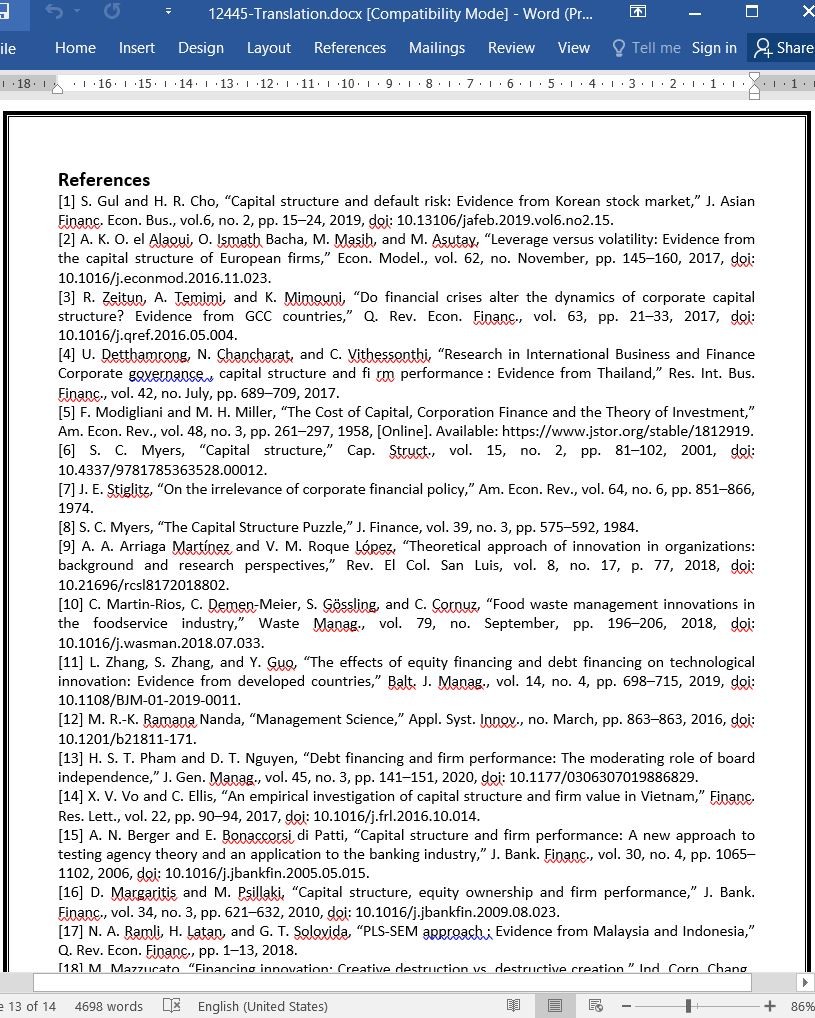
تاثیر ساختار سرمایه و نوآوری بر عملکرد شرکت. اثرات مستقیم و غیرمستقیم ساختار سرمایه
چکیده
در این پژوهش قصد داریم در میان شرکت های تولیدی کوچک و متوسط (SME ها) مکزیکی، تاثیر ساختار سرمایه و نوآوری بر عملکرد شرکت را به صورت تجربی ارزیابی کنیم و به منظور تعیین اثرات واسطه ای نوآوری، اثرات غیرمستقیم ساختار سرمایه را تجزیه و تحلیل نماییم. بر اساس مدل سازی معادلات ساختاری حداقل مربعات جزئی (PLS-SEM)، یک رویکرد کمی و طراحی مقطعی به کار گرفته شده است. برای جمع آوری داده ها از یک نمونه ۲۲۰ نفری از مدیران یا صاحبان کسب وکار در ایالت آگوئاسکالینتس در مکزیک، یک تکنیک نمونه گیری تصادفی ساده و یک پرسشنامه خودایفایی مورد استفاده قرار گرفت. یافته ها حاکی از آن است که ساختار سرمایه اثر معناداری بر نوآوری و صرفا اثر غیرمستقیم بر عملکرد شرکت دارد. از آنجایی که ثابت شده است که نوآوری نقش واسطه ای کامل و معناداری در این رابطه دارد، اگر شرکت های کوچک و متوسط می خواهند عملکرد شرکتی بهتری داشته باشند، باید سطح نوآوری خود را توسعه دهند. از این رو تصمیم گیرندگان باید توجه خاصی به سرمایه گذاری مجدد سود خود داشته باشند تا سطوح نوآوری و عملکرد شرکت را توسعه دهند.
1.مقدمه
هنگامی که در مورد امور مالی شرکت صحبت می کنیم، ساختار سرمایه یکی از مهمترین تصمیمات است، زیرا با چگونگی تامین مالی دارایی های شرکت از طریق بدهی ها و حقوق صاحبان سهام سر و کار دارد [1]. طی دهه گذشته مطالعات بین المللی متعددی به بررسی رابطه بین قدرت نفوذ و عملکرد یک شرکت پرداخته اند [2]، [3]. با این وجود تنها تعداد کمی از مطالعات به طور سیستماتیک اثبات کردند که عوامل تعیین کننده ساختار سرمایه رابطه مستقیمی با عملکرد آن دارند و این که آیا اهرم مالی بر رابطه گفته شده تاثیر می گذارد یا خیر [4]. به این صورت چندین مطالعه بر روی این موضوع متمرکز شده اند و مودیلیانی و میلر [5] مشارکت اصلی را به عهده داشتند. با این وجود استیگلیتز [7] عدم ارتباط اصطلاح بدهی را تایید کرد و سه مسیر اصلی تحقیقاتی وجود دارد که تعیین عوامل حیاتی تعیین کننده ساختار سرمایه را ممکن می کند - نمونه هایی از این موارد عبارتند از تضاد نمایندگی، عدم تقارن اطلاعاتی [1] و ترتیب سلسله مراتبی [8]. در نتیجه ما باید اثر این موارد بر عملکرد شرکت را مورد بررسی قرار دهیم.
Abstract
This research aims to empirically examine the impact of capital structure and innovation on firm performance among small and medium-sized (SMEs) Mexican manufacturing firms and analyze the indirect effects of capital structure to determine mediating effects of innovation. A quantitative approach and cross-sectional design were applied through the Partial Least Squares Structural Equation Modeling (PLS-SEM). A simple random sampling technique and a self-administered questionnaire was used to gather data from a sample of 220 managers or business owners in the state of Aguascalientes, Mexico. The results indicate that capital structure has a significant impact on innovation and only an indirect effect on firm performance. Due to the innovation demonstrated to have a significant full mediating role in this relationship if SMEs want to have better firm performance, they must increase their level of innovation. Therefore, decision-makers must pay special attention to the reinvestment of their profits to increase the levels of innovation and firm performance.
1. Introduction
Capital structure is one of the most important decisions when talking about corporative finance because it deals with how company finances its assets through liabilities and equity [1]. During the last decade, several international studies have researched the relationship between a company’s leverage and performance [2], [3]. However, only a few studies have proved systematically the direct relationship of the determining factors of capital structure in its performance and whether leverage influences said relationship [4]. In this manner, with the seminal contribution of Modigliani and Miller [5], several studies have focused on this topic. According to Myers [6], we can say that there is no universal theory of the formation of the financial structure in business, and there is not a single reason to expect one. However, Stiglitz [7] established the irrelevance of the term of indebtedness and there have been three main lines of investigation that allow to the critical factors that define the capital structure to be determined- Examples of this are agency conflicts, informational asymmetry [1] and the hierarchy order [8]. We must, therefore, analyze the effect of these on corporate performance.
چکیده
1.مقدمه
2. مروری بر مطالعات پیشین
3. روش شناسی
4. یافته ها و بحث
5. نتیجه گیری
منابع
Abstract
1. Introduction
2. Literature review
3. Methodology
4. Results and discussion
5. Conclusions
References
- اصل مقاله انگلیسی با فرمت ورد (word) با قابلیت ویرایش
- ترجمه فارسی مقاله با فرمت ورد (word) با قابلیت ویرایش، بدون آرم سایت ای ترجمه
- ترجمه فارسی مقاله با فرمت pdf، بدون آرم سایت ای ترجمه



